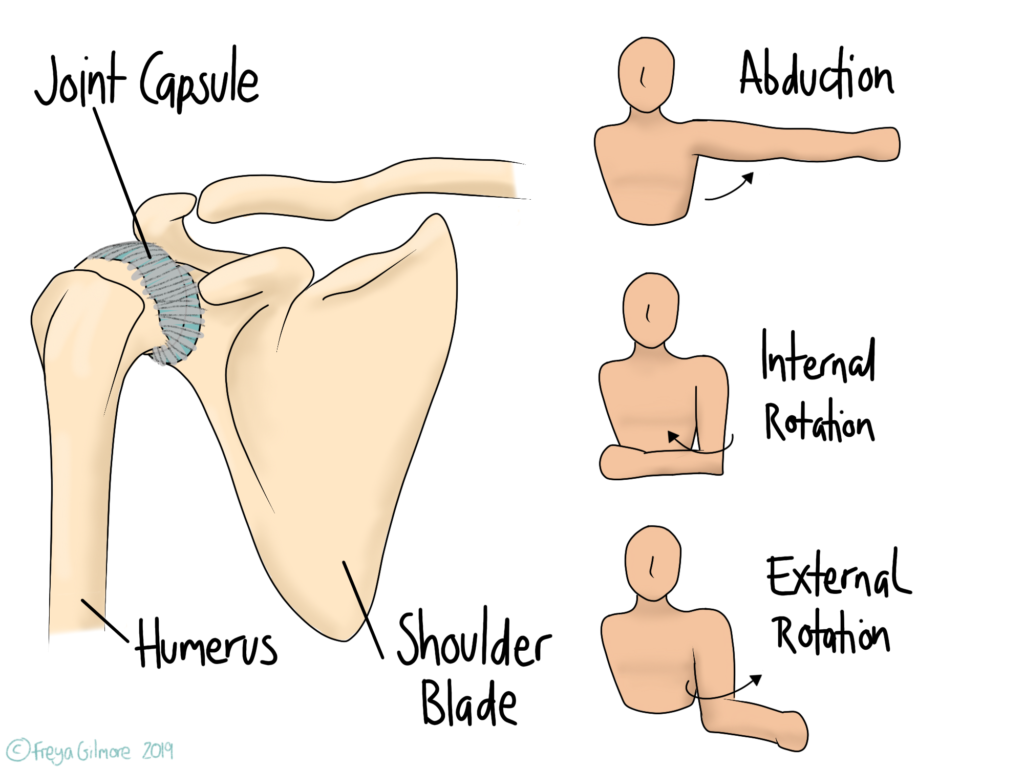Frozen shoulder (or adhesive capsulitis) is a painful condition in which the shoulder gradually loses mobility over a period of months. Eventually it “thaws”, but this can take up to three years.

What is Frozen Shoulder?
The technical term explains the problem: adhesive capsulitis literally means “sticky, inflamed capsule”. The capsule is the outer layer of the main shoulder joint. It is made of connective tissue and encases the ball and socket joint along with the cartilage and joint fluid. For reasons often unknown, the capsule can become restricted. This causes both pain and restriction in the shoulder. In contrast to other shoulder problems, movement is lost both actively (when you move the shoulder yourself) and passively (when someone else moves it while you relax the area). The three movements that are typically reduced are illustrated above: abduction, and internal and external rotation. Things like reaching into the back seat of the car, washing your hair, or getting dressed are therefore commonly affected.
Known Risk Factors
Although the onset of symptoms often happens seemingly randomly, there are some points that correlate with the development of the condition:
- trauma to the shoulder (including surgery)
- reduced use of the shoulder, such as from wearing a sling
- diabetes
Links have also been made with Parkinson’s disease, hypo- and hyperthyroidism, and some forms of heart disease. Patients affected are most commonly in their 40s or 50s.
Prognosis
Frozen shoulder can be broken down into three stages:
- Freezing stage: pain and stiffness develop slowly and steadily over a few months
- Frozen stage: pain subsides, but the stiffness remains unchanged
- Thawing stage: movement begins to return
Physical therapy such as osteopathy has been recognised as a first-line treatment to support the shoulder as it passes through the three phases. Unfortunately, even with treatment, all three stages must be passed through. Sometimes the other shoulder develops the condition within 7 years of the original onset. Reasons for this are unclear, but it may be associated with a change in demand on the healthy shoulder while the other is restricted.
Osteopathy for Frozen Shoulder
The capsule itself cannot be teased back to normal, but improving general shoulder function may speed up the process overall. You may also find that some of your pain and restriction is due to the body trying to protect itself by tensing the local muscles. Gentle massage work and mobilisation of the shoulder as a whole might therefore give you a bit more movement and comfort.
Beyond treating the affected joint, Osteopathy can help to relax the surrounding area to improve movement. A lot of shoulder movement actually comes from the joint between the shoulder blade and the ribs. This area is well supported by muscles. These muscles often become tense when the shoulder is in pain, which only reduces mobility further. Improving the function of the shoulder blade reduces the demand on the ball and socket joint and increases overall shoulder movement.
As the loss of movement affects so many daily tasks, you will likely find that you are putting an unusual demand on other areas of the body. We can work on these secondary aches and pains to provide relief and prevent more complicated issues from arising.
Click here to make an appointment for your shoulder with Beverley Palmer.
